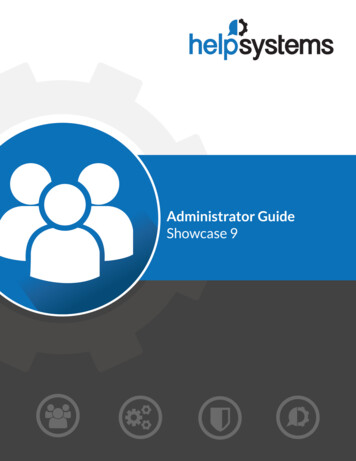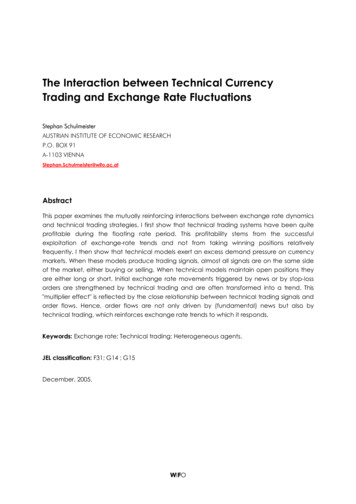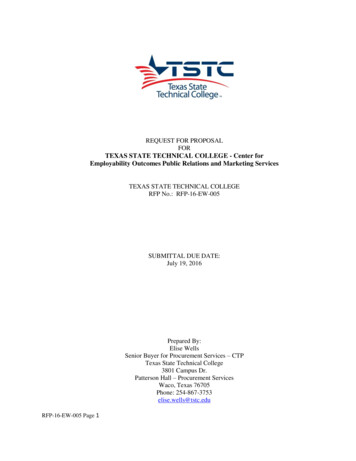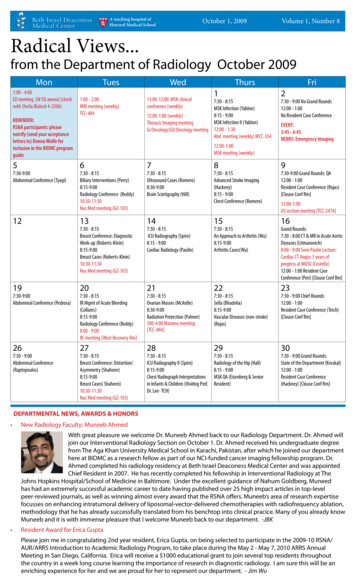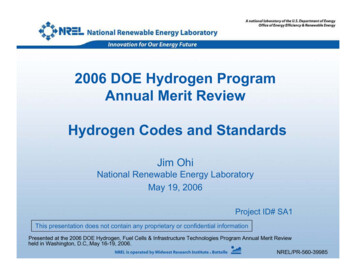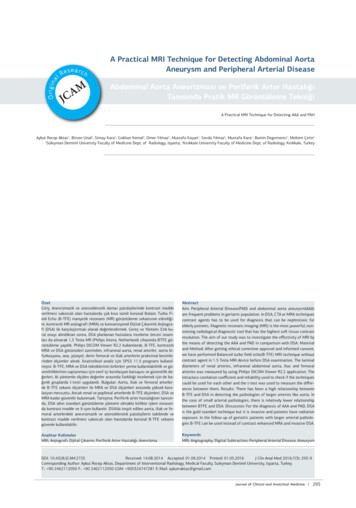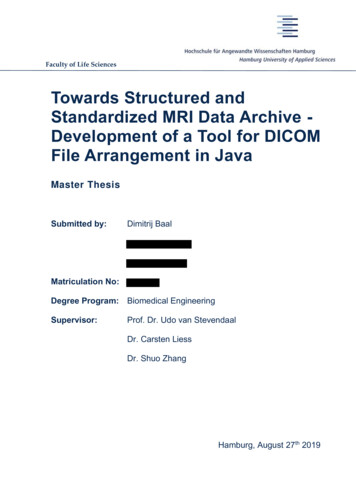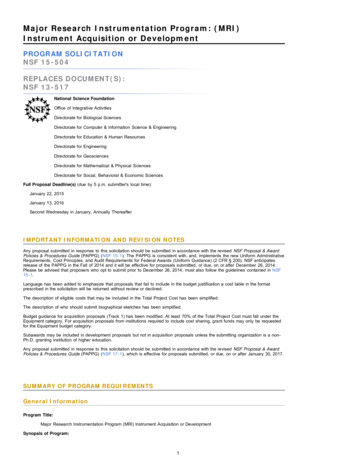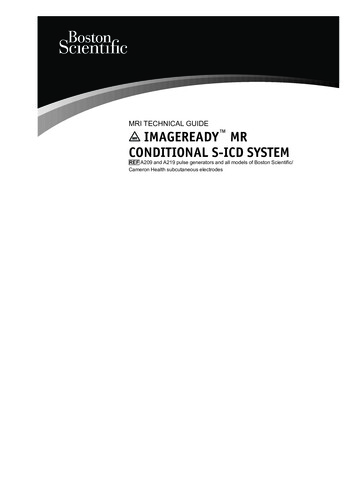
Transcription
MRI TECHNICAL GUIDEIMAGEREADY MRCONDITIONAL S-ICD SYSTEMREF A209 and A219 pulse generators and all models of Boston Scientific/Cameron Health subcutaneous electrodes
ABOUT THIS MANUALThis manual is intended for use by physicians and other health care professionals (HCPs)involved in managing patients with an ImageReady MR Conditional S-ICD System, as well asradiologists and other HCPs involved in performing magnetic resonance imaging (MRI) scans onsuch patients.NOTE: For the purposes of this Technical Guide, MRI is used as a general term andencompasses all MR-based clinical imaging activities. In addition, information in this guideapplies only to 1H MRI (Proton MRI) scanners.Read this manual in its entirety before scanning patients who are implanted with an ImageReadyMR Conditional S-ICD System.This manual contains: Information about the ImageReady MR Conditional S-ICD System (Boston Scientific S-ICDand Boston Scientific/Cameron Health Electrodes) Information about ImageReady MR Conditional S-ICD System patients who can and cannotundergo an MRI scan and the Conditions of Use that must be met in order for an MRI scan tobe performed Instructions for carrying out an MRI scan on ImageReady MR Conditional S-ICD SystempatientsHow to use this manual:1. Refer to the patient’s records to locate model numbers for all components of the patient’simplanted system.2. Refer to Table 1–1 ImageReady MR Conditional S-ICD System Components on page 1-2 todetermine if all components of the patient’s implanted system are found within the table. If notall components of the implanted system can be found within the table, the system is either apacing system, a transvenous defibrillation system, or it is not MR Conditional.NOTE: Three Boston Scientific MRI Technical Guides are available - one for pacemakers,one for transvenous defibrillators, and one for S-ICDs. If a particular pulse generator model isnot represented in this manual, refer to the ImageReady MR Conditional Pacing SystemTechnical Guide or the ImageReady MR Conditional Defibrillation System Technical Guide. Ifa particular model is not represented in any Boston Scientific MRI Technical Guide, it is notan MR Conditional system.Refer to the Pulse Generator User’s Manual, Electrode User’s Manuals, LATITUDE ClinicianManual, or Programmer User’s Manual for detailed information about non-MRI aspects ofimplantation, features, programming, and use of the components of the ImageReady MRConditional S-ICD System.The following are trademarks of Boston Scientific or its affiliates: AF Monitor, EMBLEM, IMAGEREADY, LATITUDE.
TABLE OF CONTENTSINTRODUCTION TO THE IMAGEREADY MR CONDITIONAL S-ICD SYSTEM .1-1CHAPTER 1System Description .1-2System Configuration for 1.5 T .1-2MRI Conditions of Use.1-2Cardiology .1-3Radiology .1-3MRI Protection Mode.1-3MRI Basic Concepts.1-3MR Conditional S-ICD System Warnings and Precautions.1-4General .1-4Programming Considerations.1-5MRI Site Zone III Exclusions .1-5Precautions .1-5Potential Adverse Events.1-5MRI SCAN PROCEDURE PROTOCOL.2-1CHAPTER 2Patient Flow.2-2MRI Protection Mode General Information.2-3Pre-Scan Activities .2-41. Programming the Pulse Generator for a Scan .2-42. Confirming MRI Scanner Settings and Configuration .2-93. Preparing the Patient for the Scan .2-9During the Scan .2-10After the Scan .2-10CARDIOLOGY CHECKLIST FOR THE IMAGEREADY MR CONDITIONAL S-ICDSYSTEM . A-1APPENDIX ARADIOLOGY CHECKLIST FOR THE IMAGEREADY MR CONDITIONAL S-ICDSYSTEM . B-1APPENDIX BIMAGEREADY MR CONDITIONAL S-ICD SYSTEM COMPONENTS FOR 1.5 T . C-1APPENDIX CSYMBOLS ON PACKAGING. D-1APPENDIX D
1-1INTRODUCTION TO THE IMAGEREADY MR CONDITIONAL S-ICD SYSTEMCHAPTER 1This chapter contains the following topics: “System Description” on page 1-2 “MRI Conditions of Use” on page 1-2 “MRI Protection Mode” on page 1-3 “MRI Basic Concepts” on page 1-3 “MR Conditional S-ICD System Warnings and Precautions” on page 1-4 “Potential Adverse Events” on page 1-5
1-2Introduction to the ImageReady MR Conditional S-ICD SystemSystem DescriptionSYSTEM DESCRIPTIONAn ImageReady MR Conditional S-ICD System consists of specific Boston Scientific andCameron Health model components including pulse generators, electrodes, accessories, and theprogrammer. For the model numbers of MR Conditional S-ICD System components, see Table1–1 ImageReady MR Conditional S-ICD System Components on page 1-2.The ImageReady S-ICD System was evaluated as a system for use with MRI scans performedunder the Conditions of Use described in this Technical Guide. The pulse generator uses minimalferromagnetic materials, which can interact with the fields generated during a typical MRI scan.The pulse generator’s circuits can tolerate voltages that may be induced during scans. Any partof the body may be imaged. Boston Scientific MR Conditional pulse generators and BostonScientific/Cameron Health electrodes, when used together, have mitigated risks associated withMRI scans as compared to non-MRI pulse generators. The implanted system, as opposed to itsconstituent parts, is determined to have the status of MR Conditional as described in ASTMF2503:2008. Additionally, an MRI Protection Mode has been created for use during the scan. TheImageReady S-ICD System was designed for ease of use, and MRI Protection Mode isaccessible via a single button on the main menu, isolated from all other programmable features(see "Main Menu" on page 2-5). MRI Protection Mode modifies the behavior of the pulsegenerator to accommodate the MRI scanner electromagnetic environment (see "MRI ProtectionMode General Information" on page 2-3). A Time-out feature is programmed to allow automaticexit from MRI Protection Mode after a set number of hours chosen by the user. These featureshave been evaluated to verify their effectiveness. Other MRI-related risks are further reduced byadherence to the conditions for scanning specified in this Technical Guide.For additional information, see the Boston Scientific Website at http://www.bostonscientific.com/imageready.Only specific combinations of pulse generators and electrodes constitute an ImageReady S-ICDSystem that is valid for use with 1.5 T scanners (see Table 1–1 ImageReady MR Conditional SICD System Components on page 1-2).System Configuration for 1.5 TTable 1–1. ImageReady MR Conditional S-ICD System ComponentsComponentPulse GeneratorsElectrodes and AccessoriesProgrammera.Model NumbersMR StatusEMBLEM S-ICD, EMBLEM MRI S-ICDA209, A219MR ConditionalBoston Scientific EMBLEM S-ICDElectrodeAll modelsMR ConditionalCameron Health Q-TRAK S-ICDElectrodeAll modelsMR ConditionalBoston Scientific and Cameron Health SICD Electrode Suture SleevesAll modelsMR ConditionalEMBLEM S-ICD ProgrammerAll modelsMR UnsafeaSee the Warning regarding the Programmer being MR Unsafe.MRI CONDITIONS OF USEWhile any part of the body may be imaged, the following Conditions of Use must be met in orderfor a patient with an ImageReady S-ICD System to undergo an MRI scan. Adherence to theConditions of Use must be verified prior to each scan to ensure that the most up-to-dateinformation has been used to assess the patient’s eligibility and readiness for an MR Conditionalscan.
Introduction to the ImageReady MR Conditional S-ICD SystemCardiology1-3Cardiology1. Patient is implanted with an ImageReady MR Conditional S-ICD System (Table 1–1ImageReady MR Conditional S-ICD System Components on page 1-2).2. No other active or abandoned implanted devices, components, or accessories present suchas lead adaptors, extenders, leads, or pulse generators.3. Pulse generator is in MRI Protection Mode during scan.4. As soon as MRI Protection Mode is programmed, the patient must be continuously monitoredby pulse oximetry and electrocardiography (ECG). Ensure backup therapy is available(external rescue).5. Patient is judged to be clinically capable of tolerating no Tachycardia protection for the entireduration in which the pulse generator is in MRI Protection Mode.6. Patient does not have elevated body temperature or compromised thermoregulation at timeof scan.7. At least six (6) weeks have elapsed since implantation and/or any electrode revision orsurgical modification of the ImageReady S-ICD System.8. No evidence of a fractured electrode or compromised pulse generator-electrode systemintegrity.Radiology1. MRI magnet strength1.5 T onlyRF fieldApproximately 64 MHzMaximum spatial gradient30 T/m (3,000 G/cm)MRI equipment specificationHorizontal, 1H proton, closed bore scanners only2. Specific Absorption Rate (SAR) limits for the entireactive scanNormal Operating Modea :3. Maximum specified gradient slew rate Whole body averaged, 2.0 watts/kilogram (W/kg) Head, 3.2 W/kg 200 T/m/s per axis4. The use of local receive-only coils is not restricted. Local transmit-only coils or local transmit/receive coils may beused, but should not be placed directly over the ImageReady S-ICD System.5. Patient in supine or prone position only6. Patient must be continuously monitored by pulse oximetry and electrocardiography (ECG) for the entire duration inwhich the pulse generator is in MRI Protection Mode. Ensure backup therapy is available (external rescue).a.As defined in IEC 60601-2-33, 201.3.224, 3rd Edition.MRI PROTECTION MODEIn preparation for an MRI scan, the pulse generator is programmed into MRI Protection Modeusing the programmer. MRI Protection Mode modifies certain pulse generator functions in orderto mitigate risks associated with exposing the ImageReady MR Conditional System to the MRIenvironment. For a list of features and functions that are suspended in MRI Protection Mode, see"MRI Protection Mode General Information" on page 2-3.MRI BASIC CONCEPTSMRI is a diagnostic tool that uses three types of magnetic and electromagnetic fields to imagesoft tissue in the body:
1-4Introduction to the ImageReady MR Conditional S-ICD SystemMR Conditional S-ICD System Warnings and Precautions A static magnetic field generated by a superconducting electromagnet coil, 1.5 T in strength. Gradient magnetic fields of much lower intensity, but with high rates of change over time.Three sets of gradient coils are used to create the gradient fields. A pulsed radio frequency (RF) field produced by transmission RF coils (approximately 64MHz for 1.5 T).These fields may create physical forces or electrical currents that can affect the functioning ofactive implantable medical devices (AIMDs) such as pulse generators and electrodes. Therefore,only patients implanted with an ImageReady MR Conditional System optimized and evaluated forthe ability to function correctly under specified conditions during an MRI scan are eligible to bescanned. Furthermore, by complying with the MRI Conditions of Use, outlined in this TechnicalGuide ("MRI Conditions of Use" on page 1-2), ImageReady MR Conditional System patients canundergo MRI scans with risks mitigated to the best current standard of care.MR CONDITIONAL S-ICD SYSTEM WARNINGS AND PRECAUTIONSGeneralWARNING: Ensure the device is in MRI Protection Mode before entering the scanner and thatthe patient is out of the scanner before the programmed Time-out period elapses. This willensure that inappropriate therapy and potential unintended arrhythmia induction do not occurwhile undergoing an MRI scan.WARNING: Unless all of the MRI Conditions of Use ("MRI Conditions of Use" on page 1-2) aremet, MRI scanning of the patient does not meet MR Conditional requirements for the implantedsystem, and significant harm to or death of the patient and/or damage to the implanted systemmay result.For potential adverse events applicable when the Conditions of Use are met or not met, see"Potential Adverse Events" on page 1-5.WARNING: MRI scanning after ERI status has been reached may lead to premature batterydepletion, a shortened device replacement window, or sudden loss of therapy. After performingan MRI scan on a device that has reached ERI status, verify pulse generator function andschedule device replacement.WARNING: The patient must be out of the scanner before the programmed Time-out periodelapses. Otherwise, the patient will no longer meet Conditions of Use (see "MRI Conditions ofUse" on page 1-2).WARNING: The Beeper may no longer be usable following an MRI scan. Coming in contactwith the strong magnetic field of an MRI scanner may cause a permanent loss of the Beepervolume. This cannot be recovered, even after leaving the MR scan environment and exiting MRIProtection Mode. Before an MRI procedure is performed, a physician and patient should weighthe benefit of the MR procedure against the risk of losing the Beeper. It is strongly recommendedthat patients are followed on LATITUDE NXT after an MRI scan if they are not already. Otherwise,an in-clinic follow-up schedule of every three months is strongly recommended to monitor deviceperformance.WARNING: During MRI Protection Mode, the patient will not receive Tachycardia therapy.Therefore, the patient needs to be continuously monitored for the entire duration in which thesystem is in MRI Protection Mode, including during the scan. Continuous monitoring includesmaintaining normal voice and visual contact, as well as monitoring pulse oximetry and ECG forthe entire duration that the pulse generator is in MRI Protection Mode. Ensure that an externaldefibrillator and medical personnel skilled in cardiopulmonary resuscitation (CPR) are present aslong as the pulse generator is in MRI Protection Mode, including during the scan, should thepatient require external rescue.
Introduction to the ImageReady MR Conditional S-ICD SystemProgramming Considerations1-5Programming ConsiderationsWARNING: If Tachycardia therapy is programmed Off prior to entering MRI Protection Mode,the therapy will remain Off when the MRI Protection Time-out elapses after the programmed timeperiod.MRI Site Zone III ExclusionsWARNING: The Programmer is MR Unsafe and must remain outside the MRI site Zone III (andhigher) as defined by the American College of Radiology Guidance Document for Safe MRPractices1. Under no circumstances should the programmer be brought into the MRI scannerroom, the control room, or the MRI site Zone III or IV areas.WARNING: Implant of the system cannot be performed in an MRI site Zone III (and higher) asdefined by the American College of Radiology Guidance Document for Safe MR Practices2.Some of the accessories packaged with pulse generators and electrodes, including the torquewrench and electrode insertion tool, are not MR Conditional and should not be brought into theMRI scanner room, the control room, or the MRI site Zone III or IV areas.PrecautionsCAUTION: MR scanning when other active implants such as lead adaptors, extenders, leads orpulse generators are present may increase MRI-related risks. If MR scanning is required, refer toproduct labeling to ensure that the MR conditions of use are met for all implanted products.CAUTION: Following any sensing parameter adjustment or any modification of thesubcutaneous electrode, always verify appropriate sensing.CAUTION: The presence of the implanted ImageReady S-ICD System may cause MRI imageartifacts (see "3. Preparing the Patient for the Scan" on page 2-9).NOTE: All normal risks associated with an MRI procedure apply to MRI scans with theImageReady S-ICD System. Consult MRI scanner documentation for a complete list of risksassociated with MRI scanning.NOTE: Other implanted devices or patient conditions may cause a patient to be ineligible for anMRI scan, independent of the status of the patient’s ImageReady S-ICD System.POTENTIAL ADVERSE EVENTSPotential adverse events differ depending on whether the MRI Conditions of Use (see "MRIConditions of Use" on page 1-2) are met. For a complete list of potential adverse events, refer tothe pulse generator User’s Manual.MRI scanning of patients when the Conditions of Use are met could result in the followingpotential adverse events: Damage to the pulse generator and/or electrode Muscle stimulation Patient death Patient discomfort or heating of the device and/or electrode1.2.Kanal E, et al., American Journal of Roentgenology 188:1447-74, 2007.Kanal E, et al., American Journal of Roentgenology 188:1447-74, 2007
1-6Introduction to the ImageReady MR Conditional S-ICD SystemPotential Adverse EventsMRI scanning of patients when the Conditions of Use are NOT met could result in the followingpotential adverse events: Arrhythmia induction Damage to the pulse generator and/or electrode Erratic pulse generator behavior Defibrillation therapy not available Inappropriate shock Muscle stimulation Patient death Patient discomfort due to slight movement or heating of the device and/or electrode
2-1MRI SCAN PROCEDURE PROTOCOLCHAPTER 2This chapter contains the following topics: “Patient Flow” on page 2-2 “MRI Protection Mode General Information” on page 2-3 “Pre-Scan Activities” on page 2-4 “During the Scan” on page 2-10 “After the Scan” on page 2-10
2-2MRI Scan Procedure ProtocolPatient FlowBefore proceeding with this MRI scan procedure protocol, verify that the patient and the MRIscanner meet the MRI Conditions of Use ("MRI Conditions of Use" on page 1-2). This verificationmust be performed prior to each scan to ensure that the most up-to-date information has beenused to assess the patient’s eligibility and readiness for an MR Conditional scan.WARNING: Unless all of the MRI Conditions of Use ("MRI Conditions of Use" on page 1-2) aremet, MRI scanning of the patient does not meet MR Conditional requirements for the implantedsystem, and significant harm to or death of the patient and/or damage to the implanted systemmay result.For potential adverse events applicable when the Conditions of Use are met or not met, see"Potential Adverse Events" on page 1-5.PATIENT FLOWA sample patient flow sequence for an ImageReady S-ICD System patient who needs an MRIscan is described below. For a more detailed description of the programming and scanningprocedure, see this chapter.1. MRI recommended to patient by specialist (for example, orthopedist or oncologist).2. Patient or specialist or radiologist contacts the electrophysiologist/cardiologist who managesthe patient’s ImageReady S-ICD System.3. Electrophysiologist/cardiologist determines patient eligibility for scan per the information inthis Technical Guide, and ensures communication of patient eligibility to HCPs involved inperforming the MRI scan. Before an MRI procedure is performed, a physician and patientshould weigh the benefit of the MR procedure against the risk of losing the Beeper ("Beepervolume after MRI" on page 2-4).4. If the patient is eligible, a trained HCP or Boston Scientific representative, acting under thedirection of a electrophysiologist/cardiologist, programs the pulse generator into MRIProtection Mode as close in time to the scan as reasonable. Ensure continuous monitoring ofthe patient in MRI Protection Mode. The MRI Protection Mode Settings Report is printed,placed in the patient's file, and provided to radiology personnel. The report documents MRIProtection Mode settings and details. The report includes the exact time and date when MRIProtection Mode will expire via the Time-out feature.5. The radiologist checks the patient file and any communication from the electrophysiologist/cardiologist. The radiologist verifies that adequate time remains to complete the scan basedon the programmed Time-out value. Ensure continuous monitoring of the patient before,during, and after the MRI scan.NOTE: The patient is continuously monitored for the entire duration in which the system isin MRI Protection Mode. Continuous monitoring includes maintaining normal voice and visualcontact, as well as monitoring pulse oximetry and ECG for the entire duration that the pulsegenerator is in MRI Protection Mode. Ensure that an external defibrillator and medicalpersonnel skilled in cardiopulmonary resuscitation (CPR) are present when the patient is putinto MRI Protection Mode.6. Patient undergoes scan according to the protocol outlined in this Technical Guide.7. The pulse generator is returned to pre-MRI operation, either automatically via the Time-outfeature, or manually using the programmer. If desired, system integrity may be checked byevaluating the Beeper and/or real-time S-ECGs. It is strongly recommended that patients arefollowed on LATITUDE NXT after an MRI scan if they are not already. Otherwise, an in-clinicfollow-up schedule of every three months is strongly recommended to monitor deviceperformance.
MRI Scan Procedure ProtocolMRI Protection Mode General Information2-3MRI PROTECTION MODE GENERAL INFORMATIONPrior to the patient undergoing an MRI scan, an ImageReady S-ICD System must beprogrammed to the MRI Protection Mode using the programmer. In MRI Protection Mode: Tachycardia therapy is suspended A Time-out feature is nominally set to 6 hours, with programmable values of 6, 9, 12, and 24hours Beeper is disabled (turned off)NOTE:2 days.Six hours in MRI Protection Mode reduces pulse generator longevity by approximatelyWARNING: The Programmer is MR Unsafe and must remain outside the MRI site Zone III (andhigher) as defined by the American College of Radiology Guidance Document for Safe MRPractices1. Under no circumstances should the programmer be brought into the MRI scannerroom, the control room, or the MRI site Zone III or IV areas.The following features and functions are suspended in MRI Protection Mode: Tachycardia Detection and Therapy System diagnostics (electrode impedance, battery performance monitoring, AF Monitor) Magnet detectionThe following device conditions will preclude the user from having the option to enter MRIProtection Mode (see the pulse generator User’s Manual for additional information aboutthese conditions): Magnet presence is detected by magnet sensor Tachy Episode is in progress Setup process was not completed Battery capacity status is End of Life (EOL)WARNING: MRI scanning after ERI status has been reached may lead to premature batterydepletion, a shortened device replacement window, or sudden loss of therapy. After performingan MRI scan on a device that has reached ERI status, verify pulse generator function andschedule device replacement.BeeperThe Beeper may no longer be usable following an MRI scan. Coming in contact with thestrong magnetic field of an MRI scanner can cause a permanent loss of the Beeper volume.This cannot be recovered, even after leaving the MR scan environment and exiting MRIProtection Mode. The system proactively disables the Beeper when MRI Protection Mode isprogrammed. The Beeper will remain Off upon exiting MRI Protection Mode.The Beeper will emit tones due to a device reset even after the device is programmed intoMRI Protection Mode. Although the Beeper may still be audible following an MRI scan, theBeeper volume will be decreased.1.Kanal E, et al., American Journal of Roentgenology 188:1447-74, 2007.
2-4MRI Scan Procedure ProtocolPre-Scan ActivitiesNOTE: In situations where the MRI scan did not occur, the Beeper can be re-enabled afterexiting MRI Protection Mode (see "After the Scan" on page 2-10).Upon subsequent interrogations, a notification that the Beeper is disabled will be provided onthe Device Status Since Last Follow-up screen (see "Beeper Disabled dialog" on page 2-11).If the Beeper is re-enabled, the Beeper status will no longer be provided on the Device StatusSince Last Follow-up screen.WARNING: The Beeper may no longer be usable following an MRI scan. Coming incontact with the strong magnetic field of an MRI scanner may cause a permanent loss of theBeeper volume. This cannot be recovered, even after leaving the MR scan environment andexiting MRI Protection Mode. Before an MRI procedure is performed, a physician and patientshould weigh the benefit of the MR procedure against the risk of losing the Beeper. It isstrongly recommended that patients are followed on LATITUDE NXT after an MRI scan ifthey are not already. Otherwise, an in-clinic follow-up schedule of every three months isstrongly recommended to monitor device performance.Situations that will no longer trigger the Beeper to emit audible tones following exit from MRIProtection Mode (if the Beeper is not re-enabled) include: Elective Replacement (ERI) and End of Life (EOL) indicators Electrode impedance out of range Prolonged charge times Irregular battery depletionPRE-SCAN ACTIVITIESThree activities are required before the MRI scan takes place:1. Prepare the pulse generator for the scan by programming into MRI Protection Mode ("1.Programming the Pulse Generator for a Scan" on page 2-4)2. Confirm the MRI scanner settings and configurations ("2. Confirming MRI Scanner Settingsand Configuration" on page 2-9)3. Prepare the patient for the scan ("3. Preparing the Patient for the Scan" on page 2-9)1. Programming the Pulse Generator for a ScanUse the programmer to program pulse generator entry into MRI Protection Mode.NOTE: Print or save (via End Session) any desired data from the current session prior toprogramming the device into MRI Protection Mode.From the Main Menu screen, select the MRI Protection Mode button (see "Main Menu" on page2-5).
MRI Scan Procedure Protocol1. Programming the Pulse Generator for a Scan2-5Figure 2–1. Main MenuCertain conditions in the pulse generator and/or system will cause a user request to enter MRIProtection Mode to be rejected. These include: A ventricular episode as detected and recognized by the pulse generator is in progress Magnet presence is detected by magnet sensorIf one or more of these conditions are present, a dialog box will appear describing the condition,and MRI Protection Mode cannot be entered.Upon selecting the MRI Protection Mode button, the MRI Protection Checklist screen is displayed(see "MRI Protection Checklist" on page 2-5). The Checklist summarizes the conditions that mustbe met at the time of scanning in order for a patient to be eligible for an MR Conditional scan. Reverification is required before every scan to guard against the possibility that changes in thesystem or patient occurred subsequent to the original pulse generator/system implant. Theseconditions are described in greater detail in "MRI Conditions of Use" on page 1-2.Figure 2–2. MRI Protection ChecklistIf the Conditions of Use as described in this manual are not met, the Cancel button is selected toreturn to normal system operation (Beeper has not been disabled), and the patient does notundergo an MRI scan.If the Conditions of Use are met, or if the Conditions of Use are not met but the user elects tocontinue with MRI Protection Mode after reviewing the risks of proceeding, the Continue button isselected.In addition to the above-listed conditions that prevent entry into MRI Protection Mode, anothercondition, electrode impedance, is assessed by the programmer upon a request to enter MRI
2-6MRI Scan Procedure Protocol1. Programming the Pulse Generator for a ScanProtection Mode. If the impedance value is within normal range, a screen will automaticallyappear where the user programs the current date/time and Time-out value (see "Program Date/Time and MRI Protection Time-out dialog" on page 2-6).Enter the current date and time to ensure the MRI Protection Settings Report accurately reflectsthe time of MRI Protection Mode expiration.Use the slider to set the MRI Protection Time-out (nominally set to 6 hours; programmable valuesof 6, 9, 12, and 24 hours) (see "Program Date/Time and MRI Protection Time-out dialog" on page2-6).Figure 2–3. P
A static magnetic field generated by a superconducting electromagnet coil, 1.5 T in strength. Gradient magnetic fields of much lower intensity, but with high rates of change over time. Three sets of gradient coils are used to create the gradient fields. A pulsed radio f

